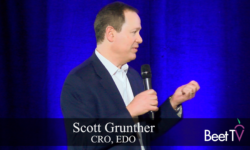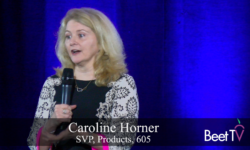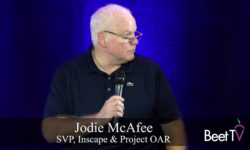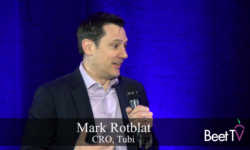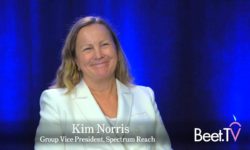SAN JUAN– We’re at the tipping point for addressable. In an interview with Alan Wolk of TVREV at the Beet Retreat earlier this month in San Juan, Tracey Scheppach, CEO of Matter More Media, explained that we’re now on the right path to increase the addressable inventory.
Scheppach was a pioneering advance TV senior executive, at Starcom then Publicis Media, before starting her own firm.
Despite all of the scale that seen from the MVPDs, only about 3% of linear television inventory has been made addressable. According to Scheppach, everyone is leaning in to light up the national inventory, giving MVPDs the opportunity to increase scale from 3% to between 25 and 30%. A lot of work is being done on the Smart TV side, too. This lights up basically anything that hits the glass, both broadcast and cable, and could add another 21% of addressable inventory.
“I think even with a conservative estimate, we could see 35% of linear television inventory be in addressable,” Scheppach says. “And I would argue all of OTT is, or should be, addressable. It’s addressable-capable so if buyers are not demanding it and requiring it to be addressable, that’s their fault.”
Much of the hard work around addressable has already been done. Now the focus has shifted to scale, specifically unification and simplicity.
“How are we going to make this easier to buy, and unified so we don’t have to buy in pockets and I could transact on several technological solutions easily?” Scheppach says.
A lot of confusion also comes down to measurement. As Scheppach points out, knowing what to buy becomes more difficult if you do not know where all of the viewing is happening. This makes unification all the more important.
“We’re starting to see a lot of competition in that space,” Scheppach said. “A lot of people are saying that they provide a full look at video consumption from a consumer. You’ve got to ask a lot of questions like how was it built? What’s the validity of that data? Does it represent real people? Is it just households? Is it IP-based?”
This could lead to some growing pains, but will also lead to unification in common measurement across all viewing. Scheppach says that this measurement needs to come from a combination of several different things including set-top box and Smart TV data, and she also points out the value of having a panel to make corrections to.
“You need to have a truth set to always go back to, like who is in the house?” Scheppach says. “We don’t want to just know household viewing, we need to get to people. And I think the only way you’re really going to get to people is to have a truth set.”
Along with changes in measurement have been changes in streaming. While some services have decided to go ad-free, Scheppach pointed to data that shows that when given the choice, viewers are still choosing to have ads. Still, these ads will likely continue to decrease, so it’s up to advertisers to now get more value out of their spots by becoming more targeted.
“Now we have to move to a place where you can actually be willing to pay more for every ad that is seen by a viewer,” Scheppach said. “And the only way you’re going to do that is if it’s targeted and measurable.”
This video was produced at the Beet Retreat San Juan 2020 sponsored by 605, DISH Media, NBCU, Roundel & Tubi. For more videos from the series, please visit this landing page.







